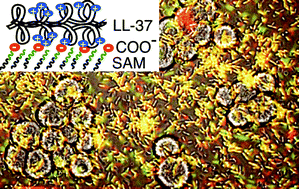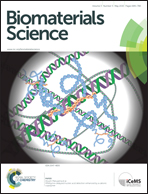Antimicrobial peptide LL-37 on surfaces presenting carboxylate anions†
Abstract
Antimicrobial peptides (AMPs) are part of the immune system in a wide range of organisms. They generally carry positive charges under physiological conditions, allowing them to accumulate on the negatively charged bacterial membrane as the first step of bactericidal action. The concentration range of AMPs necessary for rapid killing of bacteria tested in vitro is much higher than levels found at epithelial surfaces and body fluids in vivo, and close to the a level that is toxic to the host cells. It is likely that AMPs in vivo are localized and act cooperatively to enhance antimicrobial activity, while the global concentration is low thus demonstrating low toxicity to host cells. Herein we employed well-defined mixed self-assembled monolayers (SAMs) to localize LL-37, one of the most studied AMPs, via electrostatic interactions. We systematically varied the surface density of LL-37, and found that the immobilized AMPs not only attracted bacteria Pseudomonas aeruginosa to the surface, but also killed nearly all bacteria when above a threshold density. More significantly, the AMPs displayed low toxicity to human corneal epithelial cells. The results indicated that localization of AMPs on suitable polyanion substrates facilitated the bactericidal activity while minimizing the cytotoxicity of AMPs.


 Please wait while we load your content...
Please wait while we load your content...